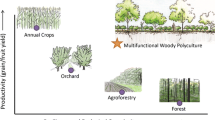Abstract
We tested the economic value of ecological knowledge in a midwestern USA alley-cropping system where row crops are planted in alleys between fine hardwood trees grown for veneer. Economic models were constructed to compare among agroforestry designs as well as to compare agroforestry with traditional forest plantation culture and row crop monoculture and rotational management. The general modeling approach was to quantify production inputs and outputs, estimate costs and revenues, simulate tree growth and crop productivity in agroforestry configurations, and estimate discounted cash flows. We incorporated scenarios that controlled both above- and below-ground competition through appropriate management as found in our previous research. This research showed the importance of below-ground competition in determining crop yields and the period of time that crop income could be expected from the agroforestry interplanting. Net present values and internal rates of return showed that agroforestry systems were generally more favorable investments than traditional agriculture and forestry. More importantly, the use of simple management techniques targeted at reducing below-ground competition allowed longer cultivation of row crops, greatly increasing returns to the landowner. Thus, the economic benefit of understanding the ecological interactions within agroforestry plantings dictates that accurate assessment of agroforestry alternatives will require the modeling of agroforestry as an integrated, interactive system.
Similar content being viewed by others
References
Bandolin TH and Fisher RF (1991) Agroforestry systems in North America. Agrofor Syst 16: 95–118
Benjamin TJ (1996) A Financial Analysis of a Black Walnut and Corn Agroforestry System. Unpublished MS thesis. Purdue University, Dept of Forestry and Natural Resources, West Lafayette, Indiana, USA, 109 pp
Callahan JC and Smith RP (1974) An economic analysis of black walnut plantation enterprises. Purdue University Research Bulletin, No. 912. Purdue University, Dept of Forestry and Natural Resources, West Lafayette, Indiana, USA, 20 pp
Campbell GE, Lottes GJ and Dawson JO (1991) Design and development of agroforestry systems in Illinois, USA: silvicultural and economic considerations. Agrofor Syst 13: 203–224
Cannell MGR (1983) Plant management in agroforestry: manipulation of trees, population densities and mixtures of trees and herbaceous crops. In: Huxley PA (ed) Plant Research and Agroforestry, pp 455–486. International Council for Research in Agroforestry (ICRAF), Nairobi, Kenya
Doster DH, Parsons SD, Christmas EP, Mengel DB and Nielson RL (1985–1995) Purdue Agricultural Economics Extension Publication, ID 166. Purdue University. West Lafayette, Indiana
Etherington DM and Matthews PJ (1983) Approaches to the economic evaluation of agroforestry systems. Agrofor Syst 1: 347–360
Garrett HE and Kurtz WB (1983) Silvicultural and economic relationships of integrated forestryfarming with black walnut. Agrofor Syst 1: 245–256
Gillespie AR, Mengel DB, Hoover WL, Pope PE, Seifert JR, Biehle DJ, Stall T, Jose S and Benjamin TJ (2000) Defining competition vectors in a temperate alleycropping system in the midwestern USA: 1. Production Physiology. Agrofor Syst 48: 25–40
Gold MA and Hanover JW (1987) Agroforestry systems for the temperate zone. Agrofor Syst 5: 109–121
Jose S, Gillespie AR, Seifert JR and Biehle DJ (2000) Defining competition vectors in a temperate alleycropping system in the midwestern USA: 2. Competition for water. Agrofor Syst 48: 41–59
Jose S, Gillespie AR, Seifert JR and Pope PE (2000) Defining competition vectors in a temperate alleycropping system in the midwestern USA: 3. Competition for nitrogen and litter decomposition dynamics. Agrofor Syst 48: 61–77
Kincaid WH (1982) Silvicultural economic assessment of black walnut management alternatives. Unpublished MS thesis, University of Missouri-Columbia, School of Natural Resources, Columbia, Missouri, USA, 99 pp
Schlesinger RC and Funk DT (1977) Manager's handbook for black walnut, USDA Forest Service General Technical Report NC-38. USDA Forest Service, North Central Forest Experiment Station, St. Paul, Minnesota, USA, 22 pp
Thomas TH (1991) A spreadsheet approach to the economic modeling of agroforestry systems. For Ecol Manage 45: 207–235
Williams PA and Gordon AM (1992) The potential of intercropping as an alternative land use system in temperate North America. Agrofor Syst 19: 253–263
Author information
Authors and Affiliations
Corresponding author
Rights and permissions
About this article
Cite this article
Benjamin, T.J., Hoover, W., Seifert, J. et al. Defining competition vectors in a temperate alley cropping system in the midwestern USA: 4. The economic return of ecological knowledge . Agroforestry Systems 48, 79–93 (2000). https://doi.org/10.1023/A:1006367303800
Issue Date:
DOI: https://doi.org/10.1023/A:1006367303800




